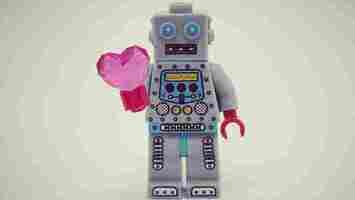These GPT-3 pick-up lines are better than the sleaze and cheese you sling on Tinder
The pandemic has been a tough time to be single. I can barely remember how to speak to my friends, let alone seduce an unlucky stranger. But thanks to AI, I no longer have to rely on my dubious charm and wit to attract the object of my affections.

Janelle Shane, a research scientist and budding cupid, recently used GPT-3 to generate pick-up lines for failed Casanovas.
Some of the results are incomprehensible and a few are plain creepy. But who could resist gems like this?
The project isn’t the first time Shane’s applied AI to the art of seduction. She’d previously created pick-up lines by training a neural net on a veritable cesspit of human-penned lines. Fortunately, the system was too primitive to reproduce the wordplay of their worst sentiments. Instead, it mostly spat out gibberish .
AI has come a long way in the intervening years, but Shane had some concerns about repeating the experiment:
She generated the lines by feeding variants of GPT-3 the prompt, “These are the top pickup lines of 2021! Amaze your crush and get results!”
The largest and most powerful model, DaVinci, returned the most lucid responses, including the aforementioned Back to the Future reference. The others ran the gamut from endearingly innocent to slightly disturbing:
The smaller Ada model, however, struggled with the assignment. Its responses sounded more like a shopping list than attempts to attract a partner:
The Babbage model, meanwhile, had mixed results. Smaller than DaVinci but larger than Ada, it didn’t always seem to understand the task. However, it did kindly provide some tips on when to use its lines:
Can’t wait to try that one out.
HT – Janelle Shane
Greetings Humanoids! Did you know we have a newsletter all about AI? You can subscribe to it right here .
These retail giants are monitoring you with facial recognition, say campaigners
Some of the biggest retailers in the US are using facial recognition to monitor people in their stores, according to new research.

A coalition of civil rights groups says that retails giants including Macy’s, Ace Hardware, and Lowe’s are currently using the tech to monitor people who enter or work in their stores.
The group is calling for the companies to end the practice.
“Constant surveillance, tracking, and data collection infringe on our human right to privacy,” said Al Smith from The Tor Project, one of 35 organizations involved in the campaign.
“Consumers and employees should be able to enter stores without fearing that facial recognition software will be cataloging their every move.”
Up-front: Retailers say they use facial recognition for security and operational purposes, from theft prevention to monitoring in-store traffic patterns. But the tech is fraught with risks.
In stores, facial recognition could be used to bar customers with criminal records from entering, discipline workers who take too many breaks, target marketing at vulnerable people, or wrongfully accuse people of crimes.
The campaigners have created an online scorecard that tracks which retailers are currently using the software, which ones aren’t, and which ones may do so in the future. In addition to the aforementioned companies, Albertsons, H.E.B Grocery, and Apple Stores are all on the list of current users, although Apple told The Verge it doesn’t use the tech in its stores.
The coalition has also created a petition urging retailers to ban facial recognition in their stores
Quick take: Scanning people’s faces without their knowledge as they go about their daily lives is a form of mass surveillance. Experts say it threatens basic privacy rights.
The software is also notoriously prone to biases and errors .
When it fails, the consequences can be devastating. Last year, an innocent Michigan man was arrested on suspicion of stealing watches from a store due to a faulty facial recognition match.
But even if the software could work perfectly, I wouldn’t want my face to be scanned and stored just because I’ve walked into a store.
Greetings Humanoids! Did you know we have a newsletter all about AI? You can subscribe to it right here .
Delusional Elon Musk claims Tesla Robot will be ‘like C3PO or R2D2’
Elon Musk made some wildly bold claims on the Lex Fridman podcast yesterday. While he’s certainly no stranger to sensationalism, it’s clear now that the line between trolling humanity and getting-high-off-his-own supply is blurrier than ever for the world’s richest man.

He’s now claiming that the Tesla Robot could be an “incredible buddy like C3PO or R2D2” and that it will be able to “develop a personality over time that is unique” because, according to Musk, “it’s not like all robots are the same.”
Musk told Fridman that Tesla would likely have a “decent prototype” by the end of next year (2022).
After introducing the “Tesla Robot” earlier this year by dressing up a dancer in spandex and trotting them out on stage to embarrass themselves, the audience, and the company, Musk claimed the machine would be available in 2022.
(
Never mind that companies such as Hanson Robotics and Boston Dynamics have been working in the space for decades or that Amazon, Apple, Google, Samsung, and dozens of other big tech outlets have invested hundreds of billions of dollars in pushing the limits of human-robot interactions.
Elon Musk’s just going to… solve artificial general intelligence by the end of next year with a team he’s only just started hiring in the past few months.
To put that into perspective: optimists such as Ray Kurzweil put a timeline around 2050-2080 for solving AGI and the general consensus of the AI community is that it’s likely to take much longer than that.
We’ve heard Musk make ridiculous claims like this before . Just a few years back, in 2019, he told the entire world that Tesla was on the verge of solving self-driving and that the company would field no less than one million fully-autonomous robotaxis by the end of 2020.
It’s almost 2022 and the number of fully-autonomous vehicles in Tesla’s portfolio is exactly zero.
And even if Tesla could solve fully-autonomous driving before the end of 2022, which is doubtful, it would still only be a fraction of the way towards achieving AGI.
The bottom line is that Elon’s ambition goes far beyond the realm of technology. Even a super genius with unlimited funding and access to the most talented AI developers in the world can’t turn modern deep learning algorithms into magical machines capable of Star Wars-level Droid sentience.
No amount of money can brute force human-level AI. And Tesla’s no closer to making a general AI than any other company on the planet – which is to say we’re likely to see nuclear fusion, useful quantum computers, and brain implants for healthy consumers before Tesla manages to create a human-sized robot that’s anything other than a gimmick.
But, you can rest assured: if Tesla does manage to convince consumers they need a 55-kilogram bipedal machine connected to Tesla’s AI software rampaging around their homes in 2022, we’ll definitely be covering that here at Neural.
H/t: Electrek